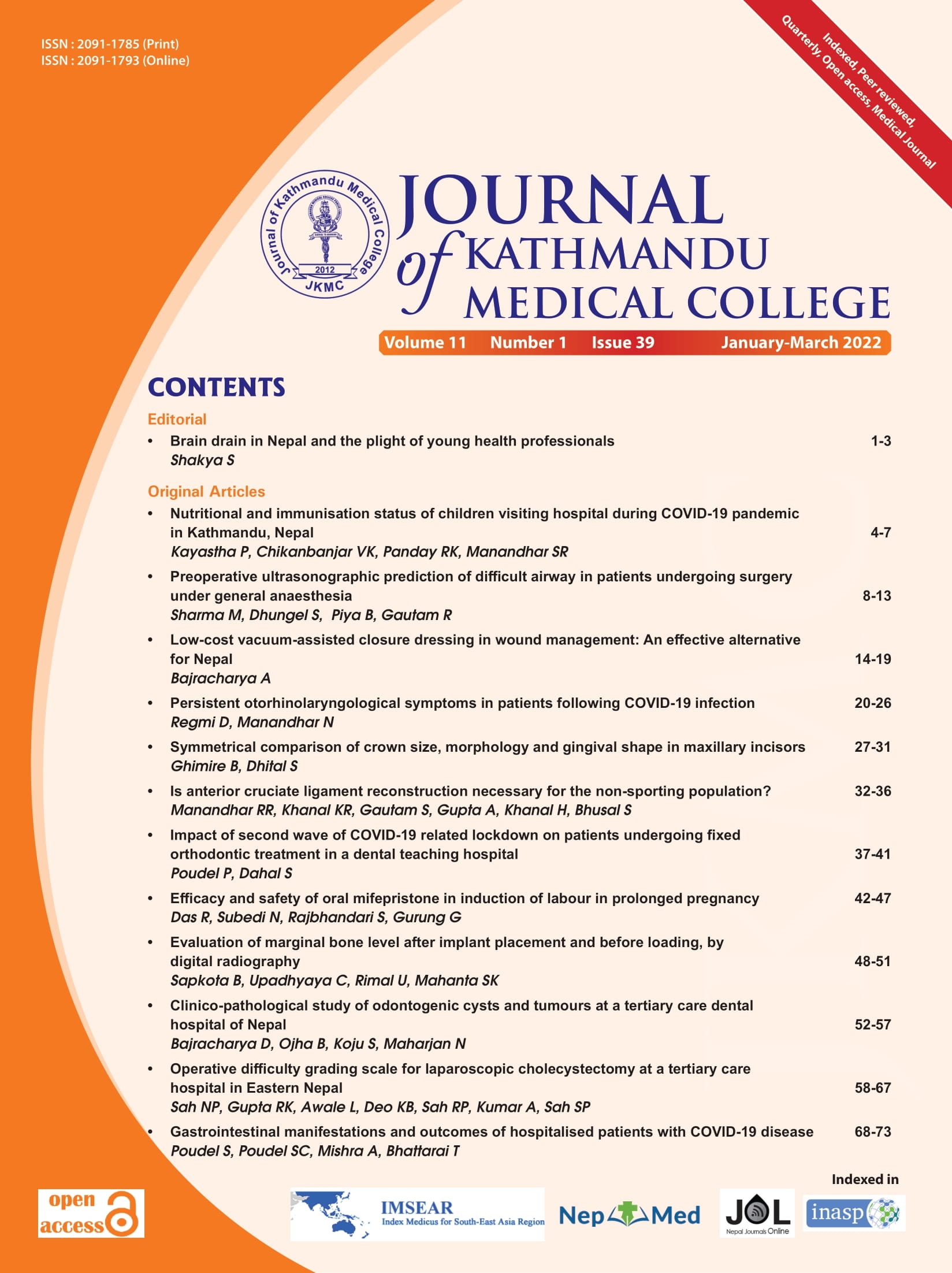Low-cost vacuum-assisted closure dressing in wound management: An effective alternative for Nepal
DOI:
https://doi.org/10.3126/jkmc.v11i1.45488Keywords:
Low-cost, Vacuum-assisted closure, Wound dressingAbstract
Background: Low-cost vacuum-assisted closure (VAC) can be used as an alternative method for wound management.
Objectives: To observe the effectiveness of low-cost vacuum-assisted closure dressing in wound management.
Methods: A descriptive cross-sectional hospital-based study was conducted in the Department of Plastic Surgery, Kathmandu Medical College from April 2021 to February 2022 to observe age, sex, indication, type of wound with history of comorbidities, number of dressings, duration of hospital stays, and complications like: bleeding, haematoma, and delay in wound healing .
Results: A total of 22 patients were included by convenience sampling technique in the study with 21 (95.5%) acute and one (4.5%) case of chronic wound with ulcer. The mean age was 39 ± 18.157 years ranging from 13-76 years. Most of them were males (15, 68.2%). The mean duration of wound presentation was 5.45 ± 9.127 days ranging from 1-45 days. The mean duration of hospitalisation was 20.45 ± 11.467 days ranging from 5-45 days. Eight (36.4%) patients were with comorbidities like Diabetes Mellitus, Hypertension, Peripheral vascular diseases etc., and no mortality was recorded.
Conclusion: Low-cost Vacuum-assisted closure is a very easy and efficient alternative method for wound care.
Downloads
References
Morykwas MJ, Argenta LC, Shelton-Brown EI, McGuirt W. Vacuum-assisted closure: a new method for wound control and treatment: Animal studies and basic foundation. Ann Plast Surg. 1997;38:553-62. [PubMed | Full Text | DOI]
Argenta LC, Morykwas MJ. Vacuum-assisted closure: A new method for wound control and treatment. Clinical experience. Ann Plast Surg. 1997;38:563-77. [PubMed | Full Text]
Genecov DG, Schneider AM, Morykwas MJ, Parker D, White WL, Argenta LC. A controlled subatmospheric pressure dressing increases the rate of skin graft donor site reepithelialization. Ann Plast Surg. 1998;40:219-25. [PubMed | Full Text | DOI]
Sämann A, Tajiyeva O, Müller N, Schauner T, Hoyer H, Wolf G, et al. Prevalence of the diabetic foot syndrome at the primary care level in Germany: A cross-sectional study. Diabet Med. 2008;25(5):557-63. [PubMed | Full Text | DOI]
Orgill DP, Manders EK, Sumpio BE, Lee RC, Attinger CE, Gurtner GC, et al. The mechanisms of action of vacuum assisted closure: More to learn. Surgery. 2009;146(1):40-51. [PubMed | Full Text | DOI]
Mouës CM, Vos MC, van den Bemd GJCM, Stijnen T, Hovius SER. Bacterial load in relation to vacuumassisted closure wound therapy: A prospective randomized trial. Wound Repair Regen. 2004;12(1):11- 7. [PubMed | Full Text | DOI]
Kairinos N, Voogd AM, Botha PH, Kotze T, Kahn D, Hudson DA, et al. Negative-pressure wound therapy II: Negative-pressure wound therapy and increased perfusion. Just an illusion? Plast Reconstr Surg. 2009;123(2):601-12. [PubMed | Full Text | DOI]
Hsu S, Thakar R, Li S. Haptotaxis of endothelial cell migration under flow. Methods Mol Med. 2007;139:237-50. [PubMed | Full Text | DOI]
Breen E, Tang K, Olfert M, Knapp A, Wagner P. Skeletal muscle capillarity during hypoxia: VEGF and its activation. High Alt Med Biol. 2008;9(2):158-66. [PubMed | Full Text | DOI]
Timmers MS, Le Cessie S, Banwell P, Jukema GN. The effects of varying degrees of pressure delivered by negative-pressure wound therapy on skin perfusion. Ann Plast Surg. 2005;55(6):665-71. [PubMed | Full Text | DOI]
Apelqvist J, Armstrong DG, Lavery LA, Boulton AJM. Resource utilization and economic costs of care based on a randomized trial of vacuum assisted closure therapy in the treatment of diabetic foot wounds. Am J Surg. 2008;195(6):782-8. [PubMed | Full Text | DOI]
Philbeck Jr TE, Whittington KT, Millsap MH, Briones RB, Wight DG, Schroeder WJ. The clinical and cost effectiveness of externally applied negative pressure wound therapy in the treatment of wounds in home healthcare medicare patients. Ostomy Wound Manage. 1999;45(11):41-50. [PubMed | Full Text]
Dodenhoff RM, Howell GE. The shoelace technique for wound closure in open fractures: report of early experience. Injury. 1997;28:593-5. [PubMed | Full Text | DOI]
Asgari MM, Spinelli HM. The vessel loop shoelace technique for closure of fasciotomy wounds. Ann Plast Surg. 2000;44(2):225-9. [PubMed | Full Text | DOI]
Sawant MR, Hallett JP. The paper-clip modification to the vessel loop “shoelace” technique for delayed primary closure of fasciotomies. Injury. 2001;32(8):619-20. [PubMed | Full Text | DOI]
Downloads
Published
How to Cite
Issue
Section
License
Copyright © Journal of Kathmandu Medical College
The ideas and opinions expressed by authors or articles summarized, quoted, or published in full text in this journal represent only the opinions of the authors and do not necessarily reflect the official policy of Journal of Kathmandu Medical College or the institute with which the author(s) is/are affiliated, unless so specified.
Authors convey all copyright ownership, including any and all rights incidental thereto, exclusively to JKMC, in the event that such work is published by JKMC. JKMC shall own the work, including 1) copyright; 2) the right to grant permission to republish the article in whole or in part, with or without fee; 3) the right to produce preprints or reprints and translate into languages other than English for sale or free distribution; and 4) the right to republish the work in a collection of articles in any other mechanical or electronic format.




